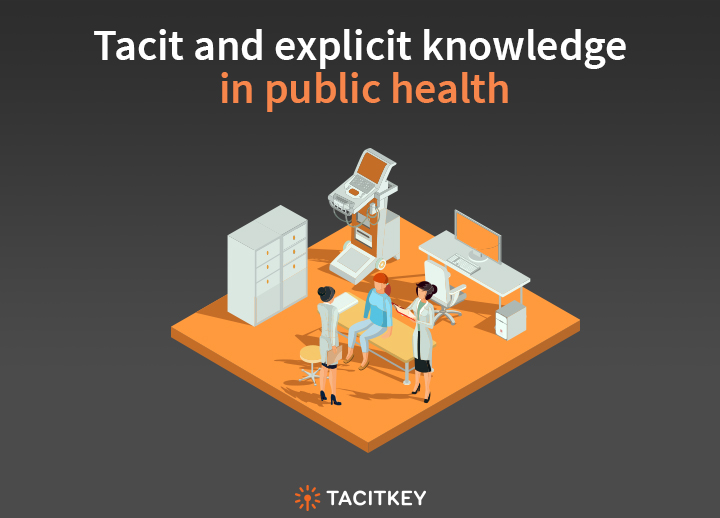- Invest in our thought leaders. Achieve your business goals. TacitKey For Business

Expert Opinions: Can Robotics result in doctor-less hospitals in the future?
June 7, 2018
Expert opinions: Blockchain in Healthcare Industry
June 18, 2018The healthcare sector is knowledge-intensive, and if recent times have proven anything, it is that this is an undisputed fact. In the past few decades alone, the industry had to tackle an unprecedented number of new and persistent threats to public health. Resurgent infectious diseases like H1N1 influenza, impending risks of bioterrorism, aftermaths of natural disasters, and the challenges of chronic diseases, to name a few. The healthcare sector has responded with a renewed commitment to overhaul the methods behind public health information translation and assimilation, simply put- healthcare knowledge management. This new collaborative method of information exchange between healthcare data analysts and medical practitioners is now called Knowledge Translation. In this article, we discuss what Tacit and Explicit knowledge mean to public health.
As a prelude to this discussion, there is a need to understand the difference between Tacit and Explicit knowledge in healthcare. Tacit knowledge is a non-codified type of knowledge. It is a form of expertise that exists subconsciously as an illustration of human abilities. According to Michael Polanyi, “tacit knowledge is something that is difficult to communicate and acquired through practice and experience rather than through language. It is possible to know more than we can tell.” He further explains that tacit knowledge has a relation with a person’s skills, which in this context, is embedded in his consciousness.
Rodney McAdam defines tacit knowledge as “a knowledge-in-practice developed from direct experience and action; highly pragmatic and situation specific; subconsciously understood and applied; difficult to articulate; usually shared through interactive conversation and shared experience.” Over the years, tacit knowledge has been referred to using various terms like essential/developed skills, implicit knowledge, general know-how, intuition, and practical knowledge.
The expression of tacit knowledge can be either neuromuscular or cognitive. A neuromuscular system involving tacit knowledge example is skating. While management skills or understanding the vital signs of a patient, beyond indicated readings, come under cognitive.
Explicit knowledge is simply the codified form of knowledge. A simple example is the periodic table.
“Explicit Knowledge follows rationality, tends to be metaphysical and objective, often relates to past events or objects ‘there and then’, and orients towards a context-free theory,” according to Nonaka & Takeuchi.
Tacit and explicit knowledge has been seen as inseparable in healthcare by some experts. It is indeed true for many tasks that demand an amalgamation of both types of knowledge. A straightforward example is Surgery. It requires combining of tacit and explicit knowledge (judgment, skill, knowledge of human body, etc.) each second.
The healthcare industry believes tacit knowledge will play a vital role as a resource that is at the center of an organization’s advancement and give it a competitive edge. In fact, a lot of research has gone into tracing how this type of knowledge is created, stored and shared in the industry. Ikujiro Nonaka of The Institute of Business Research, Hitotsubashi University in Tokyo describes a “knowledge cycle” that conceptualizes the various forms tacit knowledge takes in the healthcare industry. The model has four categories or methods of knowledge translation:
Externalization- translating tacit knowledge into explicit knowledge
Combination- producing new explicit knowledge from available codified knowledge sources.
Internalization – the process of developing explicit knowledge into tacit form.
Socialization- promoting tacit knowledge growth through sharing of experience.
People who make up the healthcare industry are either consciously or involuntarily involved in this cycle of knowledge dissemination. This makes the knowledge translation in healthcare a dynamic process.
Knowledge management in healthcare
Knowledge management is a continuous process. It involves the conception, distribution, and application of knowledge within or between related organizations.
The volume of information in the healthcare industry is mind-boggling. Industry giants are looking at new ways make this information easily accessible. But most of this knowledge is Tacit. For example, experienced physicians sift through nearly 2 million pieces of information in their mind when treating a patient.
Doctor’s spend one-third of their time recording and relating information. An almost similar percentage of revenue is paid by healthcare organizations on personal and professional communication. It is said that a medical professional increases his knowledge in the field nearly four times over during his lifetime. Add to it the rate at which new medical findings and discoveries come out every day, makes it almost impossible to practice quality medicine without frequently updating our knowledge. Knowledge Management is therefore critical in healthcare for optimal performance with a minimal price tag put on the services while managing greater quality index. The fact that the healthcare sector makes up a significant percentage of a country’s GDP and revenue source means that any improvements, however small, will result in significant benefits.
One of the blinding obstacles to knowledge translation is that most of the technical “know-how” is confined to the minds of employees in the form of tacit knowledge. A good knowledge management practice can enable sharing of this tacit knowledge across and within organizations by socializing or externalizing it to explicit format.
According to Takeuchi, “to make tacit knowledge explicit, there is substantial dependence on figurative language and symbolism. An inviting organizational atmosphere is crucial for smooth knowledge flow. Individuals must be willing to share their know-how with colleagues without fear of personal value loss and impact on job security. Employees are more likely to communicate freely in an informal atmosphere with peers than when mandated by management”. Knowledge management is all about creating such an environment for information sharing.
Knowledge sharing and new administrative policies are already making inroads in an increasing number of healthcare organizations and institutions. One can surely envision an increase in the number and response for these initiatives in the years to come. The onus is on the healthcare sector, its representatives and thought leaders to model KT strategies that will focus on the integration of explicit and implicit knowledge as well as the development of knowledge, capacity, and skills to do this.





